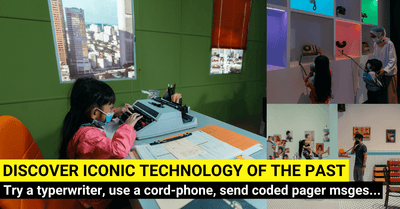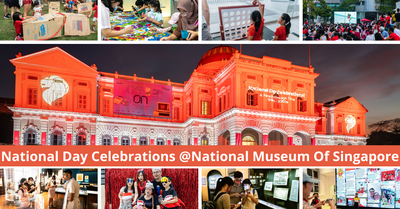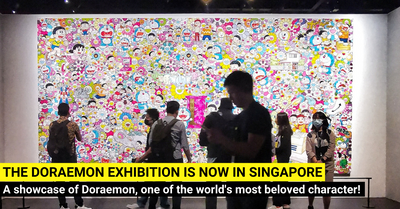The National Heritage Board showcase features product prototypes co-developed by four pairs of local craft practitioners and contemporary studios.

Venue: National Museum of Singapore
Date: 1 - 31 July 2022
Admission: Free
The making of traditional Chinese lanterns is an ancient practice that may be traced back to the Han Dynasty era in China. The art of rangoli is a multi-coloured floor decoration that originated in India and dates back thousands of years. Today, the products of these age-old crafts, along with others such as ketupat weaving and Peranakan beadwork and embroidery, have been reimagined into contemporary product prototypes as part of the National Heritage Board’s (NHB) inaugural Craft X Design showcase.
Local Craft Meets Contemporary Designs

From 1 to 31 July 2022, members of the public can experience the creative amalgamation of the traditional and the contemporary through a showcase of these product prototypes at the National Museum of Singapore, Longer Concourse. Brought together through an open call last year, four teams – each comprising one local craft veteran and one contemporary designer/design studio – produced prototypes that draw on traditional techniques, cultural influences and modern design trends.
The project is aimed at helping traditional local craft discover new audiences, modernising the crafts and creating new markets to ensure the craft's long-term
sustainability and commercial viability.
Let's take a look at the 4 teams at the showcase.
Traditional Chinese Lanterns - Harmony Spheres Lamp

Mr Jimm Wong, one of the last traditional Chinese lantern makers in Singapore speacialising in making Foochow lanterns, together with NextOfKin Creatives (NOK), a branding and industrial design firm, reinterpreted the traditional Chinese lantern as an elegant dining lamp. Harmony Spheres symbolises the harmony of the traditional and the contemporary, by preserving the lighting function and the bamboo strips of a traditional Chinese lantern, while adding a contemporary spin through its unique multi-spherical structure.
The lamp is further inspired by the Chinese ivory puzzle ball, with its intricately carved layers which can rotate individually. Drawing on Wong’s experimentation with bamboo’s material properties, and the NOK team’s expertise in 3D design, the completed structure moulds rigid bamboo ribs to form a sleek round curvature. The lamp’s open-ended spheres further produce a layered and textured lighting effect, and the translucent exterior design accentuates the graceful arc of the bamboo ribs, held together by 3D-printed rims.
Ketupat Weaving - Raya Furniture

Mdm Anita Tompang started learning the skills of ketupat weaving at the age of 9, and now has nearly 50 years of experience with it. Although ketupat weaving has become less common, she has persisted in her efforts to keep this craft alive in Singapore, including by teaching and promoting ketupat weaving, and by experimenting with and applying a range of different ketupat weaving forms and techniques.
Together with designer, Andrew Loh, the team has transpose the ketupat raya onto contemporary furniture, by creating foam modules in the shape of the ketupat raya to pay tribute to the sophistication and versatility of the weaving techniques.
Instead of coconut leaves and rice cakes, strips of thick felt were woven around foams of different densities, inspired by the function of ketupats as containers. Each module was woven or riveted together with other modules, which were stacked in different combinations to create the bench and stool on display. The modular nature of the furniture responds to the growing trend of creative designed spaces, and encourages users to experiment with (re)assembling the modules for a variety of functional everyday uses.
Peranakan Beadwork and Embroidery - Rejuvenation Gown

Mr Raymond Wong has been practicing Peranakan beadwork and embroidery for more than 16 years and is one of the last few Peranakan kebaya makers in Singapore. Working with Aller Row is a Singapore-based fashion label founded by fashion and textile designers Joanna Lim and Joanne Quak, the team created Rejuvenation. a contemporary take on the traditional Peranakan kebaya.
It adapts and incorporates elements of the Peranakan kebaya onto a cape-sleeved couture gown, which fuses Lim and Quak’s joint vision of creating fashionwear tailored for modern women, and showcasing Wong’s interest in Peranakan culture and expertise in traditional embroidery techniques.
The gown features a resplendent array of colours and motifs that draw on Peranakan culture, including colours such as turquoise or fuchsia commonly found in the Peranakan kebaya, as well as motifs depicting local or auspicious flora and fauna, such as the lotus flower. Wong’s lacework is applied on and around the printed motifs, such as the butterflies on the sleeves, adding a softer touch to the elaborate digital print design.
Rangoli - Refined Rangoli Metalware

Ms Vijaya Mohan has been practicing rangoli since the age of 5 and now has over 55 years of experience in the craft. She has created more than 8000 rangolis in Singapore, and she currently holds the Guinness World Record for the largest rangoli pattern ever created.
She has actively experimented with using new materials and contemporary designs for her rangoli works, and teams up with Jarrod Lim of Jarrod Lim Designs to reimagine regonli art as a three dimensional artform.
Rangoli has typically been a two-dimensional artform, whose motifs and patterns are drawn on the ground and/or applied to other flat surfaces and mediums. Refined Rangoli widens the possibilities of rangoli art by translating its patterns onto three-dimensional metalware, including a lampshade and a bowl, that combines decorative form with new practical applications.
Refined Rangoli combines Lim’s product design experience with the strong visual identity of Mohan’s rangoli works, resulting in industrially produced metalware which preserves rangoli’s artistic flavours and cultural expressions. Tapping on laser cutting technology, intricate rangoli motifs, including the peacock, were carved onto slices of stainless steel. The thin and flexible metal slices were then folded by hand into the form of the lampshade and the bowl.
Showcase at National Museum of Singapore
Families can visit the Craft X Design showcase at the National Museum of Singapore from 1 to 31 July 2022 to get a better appreciation of the traditional craft and how it infused with modern designs.
Entry to the showcase is free.



![30+ Of The Best Kid-friendly Museums And Exhibition in Singapore For All Ages [2024 UPDATED]](http://www.bykido.com/cdn/shop/articles/c2b80d63041615fedc7f3b0047c2c6b4_400x.png?v=1658458759)



